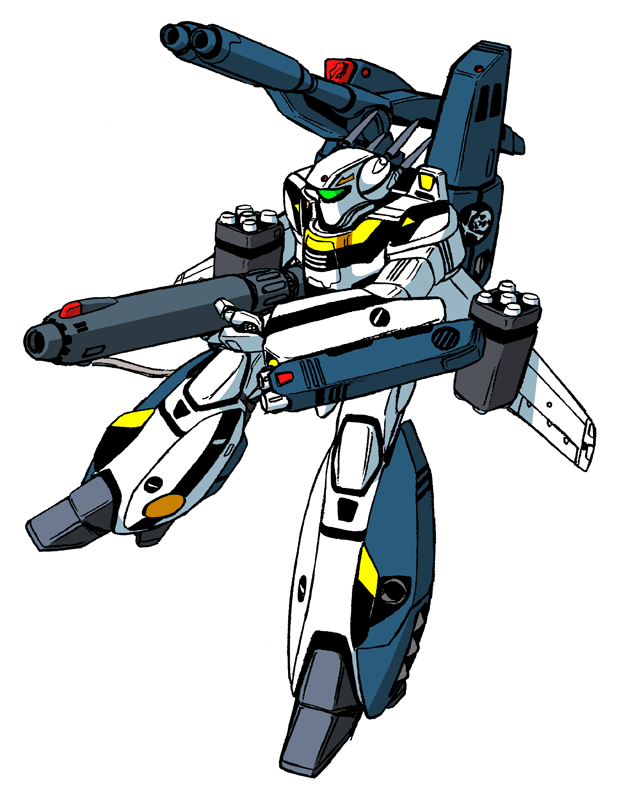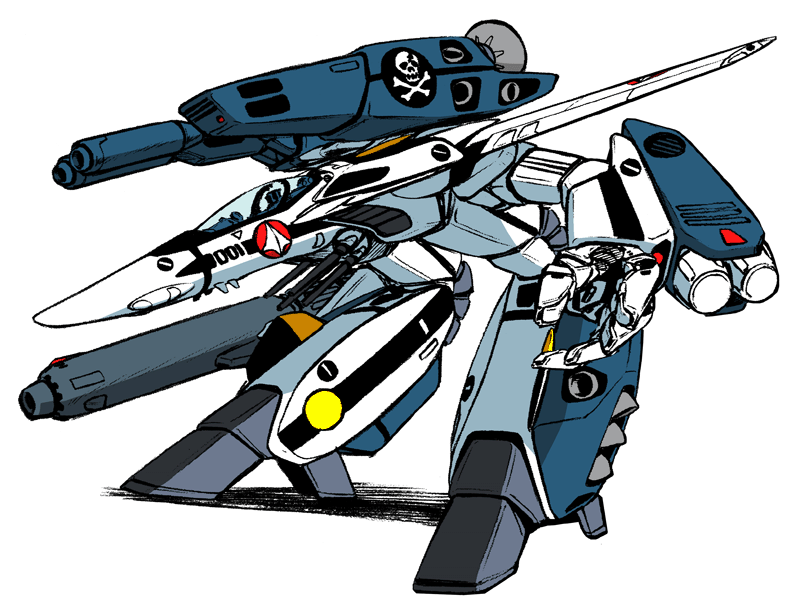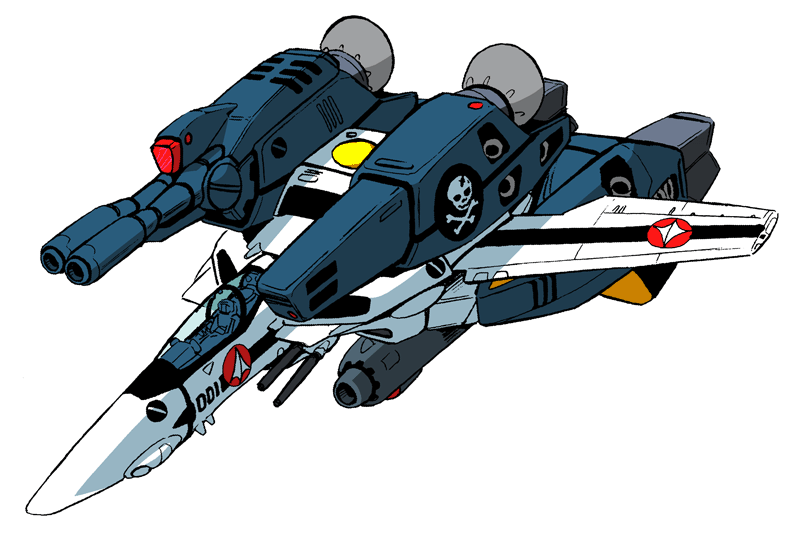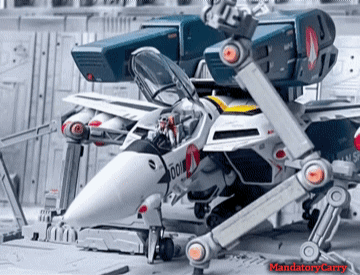 Clariont Battle Ensign Flown By Militry Bases And Ships. |  Clariont Battle Ensign Flown By Militry Bases And Ships. | ||||||||||||||||||
|---|---|---|---|---|---|---|---|---|---|---|---|---|---|---|---|---|---|---|---|
The Strike Veritech is a special variation of the original SVF-1 Super Veritech that replaces one of the HMMP-02 Medium Range Missile launcher pods on the back of the Mecha with a single Mauler
The Strike Veritech was a variation of the Super Veritech developed by Doctor R. BURKE shortly after the SDF-1 returned to Earth after accidently folding to the edge of the solar system. The Veritech was designed especially for the purpose of destroying T'sentrædi spaceships, and was intended to complement the Super Veritechs as the primary defense mecha of the SDF-1 and RDF. BURKE hoped to combine squadrons of Super and Strike Veritechs together, so that the Super Veritechs could engage the T'sentrædi mecha while the Strike Veritechs took out the motherships with their nuclear missiles. Unfortunately, only a handful of Strike Veritechs were constructed before Trati Brek Kemma DOLZA'S Armada of 4 million Warships attacked and all but destroyed the Earth. The few Strike Veritechs that were operational defended the SDF-1 admirably, disabling or destroying dozens of T'sentrædi Warships before they could even fire the Robotech defenders. Only a dozen Strike Veritechs survived DOLZA'S attack on Earth, and without exception all of these were assigned to the orbiting ARMD platforms, and later transferred to the captured Robotech Factory. No more were ever constructed, since the RDF could no longer afford to produce the sophisticated nuclear missiles that were the primary weapons of the Veritech. Unfortunately (or maybe fortunately), only 20 "Angel of Death" missiles were left in the RDF's arsenal after DOLZA's attack, and these were kept under maximum security in the Robotech Factory. When the SDF-3 left on it's mission to Tirol, the remaining Strike Veritechs were left behind to guard the Robotech Factory, and were subsequently lost when the Factory vanished shortly before the Second Robotech War. The main weapon of the Strike Veritech was the impressive "Angel of Death" Reflex-guided cruise missile. These missiles, developed and constructed at RDF Base Siberia, were designed to be small enough to be carried by fighters, but powerful enough to do real damage to T'sentrædi space cruisers. Unfortunately, the final missile design was not compatible with the standard RDF long-range missile launchers. A new version of the Lancer space fighter was designed to carry the missiles, but the prototypes were scrapped when Doctor BURKE announced his plans to design a variation of the Veritech fighter that could carry the missile. 240 missiles were shipped to the SDF-1 for testing, while the rest remained stockpiled at Base Siberia until the prototypes were perfected. This was regrettable, as the stockpiles and production facilities were vaporized when Base Siberia was destroyed by a direct hit from a T'sentrædi heavy particle beam. The Strike Veritech was also equipped with an experimental beam cannon that was modeled after the T'sentrædi particle beam cannon mounted on most of their mecha. Doctor BURKE hoped this weapon would give the Veritech an additional edge on enemy mecha it faced when it could not be protected by Super Veritechs. Strike Veritechs were only produced in the VF-1S styles, as they were never intended to be assigned to anyone but squadron leaders and aces whose loyalty to the RDF was unquestionable. The REF's decision to restart the Strike Veritech program was the necessity to deploy combat ready, one-system weapons platforms, mostly for the Sentinel Alliance Defense Forces. The development of a new nuclear missile, dis-ingenuously dubbed the Angel of Death, added significalty to the firepower capability, but the missile is considered a "reserve system", and must be deployed on a case-by-case basis. The Strike Veritech, like the Super Veritech, is now considered a main front-line platform, specifically as an attack/strike system. Vehicle Type: VF-1S Strike Class: Tactical Variable Fighter Crew: One pilot wearing Tactical Life Support System. MDC By Location: | |||||||||||||||||||
| *Torso Pilot's Compartment Legs/Thrusters Arms Hands GU-11 Gun Pod | 300 200 200 each 100 each 50 each 100 | Head Head Mounted Lasers Retractable Utility Arms Wings Tailerons Backpack-style Pods (2) | 100 30 each 3 each 150 each 50 each 200 | ||||||||||||||||
| Note: * Destruction of the main body will shut the unit down completely. Speed and Statistical Data: | |||||||||||||||||||
| Speed: Running: Battloid Mode: 100 mph (160 kmph). Guardian Mode: 60 mph (160 kmph). Leaping (either mode): 30 ft (9 m) high or 50 ft (15.2 m) long without thrusters. Running: Guardian Mode: 312 mph (500 kmph) maximum speed limit in an Earth-like atmosphere. Can also hover in place indefinitely. Jet Mode: Mach 3.87+ (2593 mph/1621 kmph). Operational Ceiling: Trans-Atmospheric. Height: Battloid Mode: 47.0 ft (14.10 m). Guardian Mode: 29.0 ft (8.70 m). Jet Mode: 12.8 ft (3.84 m). Width: Battloid Mode: 18.2 ft (5.45 m). Guardian and Jet Modes: 49.3 ft (14.78 m) with wings at maximum extension. | Length: Battloid Mode: 16.0 ft (4.80 m). Guardian Mode: 37.3 ft (11.30 m). Jet Mode: 47.4 ft (14.23 m). Weight: 45,000 kg. Physical Strength: Equal to a P.S. of 50. Cargo: Small compartment behind pilot's seat for personal belongings. Powerplant: Twin Shinnakasu/P&W/Roice FF-2001 thermonuclear turbine engines (FF-2001D in VF-1S). Quad Shinnakasu NBS-1 vernier thrusters. Eighteen P&W LHP04 vernier thrusters. Shinnakasu Industry Super Valkyrie FAST Pack space booster system Twin P&W+EF-2001 booster thrusters. Twin leg/engine-pod-mounted CTB-04 conformal propellant tanks Numerous high-manoeuvrability burner thrusters in two dorsal-mounted Twin leg/engine-pod-mounted systems. | ||||||||||||||||||
| Weapons Systems: | |||||||||||||||||||
| 01. Jet Fighter High Powered Lasers (2): A pair of lasers are built into the nose of the Veritech Fighter for aerial dog fighters and assault. They are limited to a straight ahead line of fire, however, unlike the 1999-2020 version, the new series retains these lasers in both Jet and Guardian Modes. MD: 6D6 M.D. per twin blast. Range: 4000 feet (1200 m). Rate Of Fire: Equal to the pilot's combined number of attacks. Payload Effectively Unlimited. 02. Head Lasers (4 or 5): Mounted on the head when in Battloid Mode, but located on the underbelly when in Gerwalk and Fighter mode. 360 degree rotation. Both models have two attacks per melee or one extended blast. MD: 1D4 MD per laser; 4D4 MD for the S, 5D4 for the Z. One long, extended blast lasts one full melee and does double damage; Counts as two attacks that melee and can not be used against fast moving/dodging opponents. Range: 2000 feet (600 m). Rate Of Fire: Equal to the pilot's combined number of attacks. Payload: Effectively Unlimited. 03. Medium Range, Medium Warhead Missiles: Two missiles are housed in each forearm for a total of four missiles. MD: Varies with Warhead type, usually armor-piercing or plasma (2D6 times 10 MD). Range: Varies with missile type; 50-80 miles. Rate Of Fire: One or two at a time. Payload: 2 per arm; 4 total. 04. HMMP-02 Missile Launcher Pod: A single missile launcher pod is mounted on the left back of the Veritech, along with the left super rocket booster. It carries 20 medium-range, medium-Warhead missiles. It is identical to the the missile launcher pods of the Super Veritech.  Missile Types: Any type of Medium Range Missile can be used. Missile Types: Any type of Medium Range Missile can be used.MD and Range: Varies with missile type, typically 2D4 times 10 MD at 60 miles (80.4 km). Rate Of Fire: Volleys of 2 or 4 missiles. One volley constitutes one melee attack, regardless of the number of missiles fired. Payload: 20 missiles. 05. Mauler RO-X2A Beam Cannon: A double-barrelled beam cannon is mounted on the right back of the Veritech along with the right super rocket booster, instead of the standard missile launcher pod.  MD: 4D10 M.D. per dual blast. MD: 4D10 M.D. per dual blast.Range: 4000 ft (1200 m). Rate Of Fire: Equal to the pilot's combined number of attacks. Payload: Effectively Unlimited. 06. GU-11 55MM Tri-Barrel Gun Pod: The standard issue armament for VF series Veritech.  MD: Does 3D6 MD per short burst, 6D6 MD per long burst, or 1D6 times 10 MD for a full melee burst. MD: Does 3D6 MD per short burst, 6D6 MD per long burst, or 1D6 times 10 MD for a full melee burst.Range: 4000 ft (1200 m). Rate Of Fire: Equal to the pilot's combined number of attacks. Payload: 200 rounds per clip equals 20 short bursts, 10 long bursts, or 5 full melee bursts. Inserting a new ammo clip takes half a melee round; player forefits 1/2 of his attacks. One spare clip is stored in each leg of the Veritech. | 07. Medium- or Long-Range Missiles: The Super and Strike Veritechs can substitute it's nuclear missiles with standard UN Spacy medium- or long-range missiles. Three long-range missiles or nine medium-range missiles can be mounted per wing. Missile Types: Any type of Medium Range or Long Range Missile can be used. MD and Range: Varies with missile type. Rate Of Fire: 1 at a time or volleys of up to 6/18 (all) missiles. Payload: Up to 6 long-range missiles or 18 medium-range missiles. 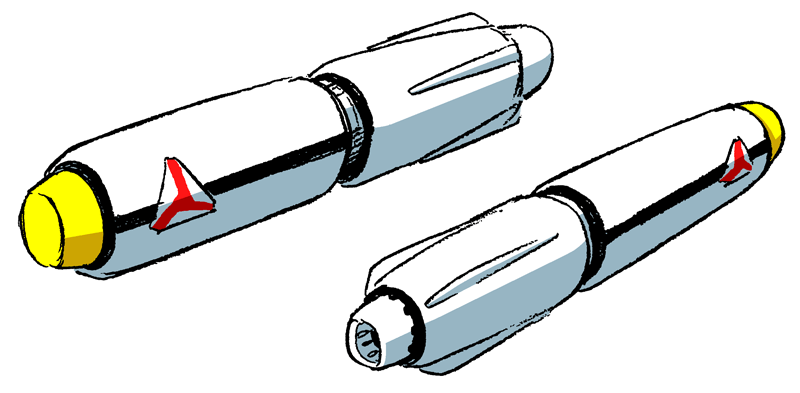 08. Optional use of RMS-1 Nuclear Cruise Missiles: The standard wing-mounted missiles for Veritechs can be replaced with nuclear cruise missiles. Three missiles can be mounted on each wing, for a total of six per Veritech. The missiles are AI-guided, and have a bonus of +5 to strike, +4 to dodge, and two attacks per melee until it hits. The missiles will always strike the center (ussually the hull) of their target. 08. Optional use of RMS-1 Nuclear Cruise Missiles: The standard wing-mounted missiles for Veritechs can be replaced with nuclear cruise missiles. Three missiles can be mounted on each wing, for a total of six per Veritech. The missiles are AI-guided, and have a bonus of +5 to strike, +4 to dodge, and two attacks per melee until it hits. The missiles will always strike the center (ussually the hull) of their target.Missile Speed: 670 mph (Mach 1). MD: 3D6 times 1,000 MD at ground zero. Reduce damage by a factor of 10 for every 2,500ft (750m) the object is away from ground zero. (i.e. 3D6 times 100 MD at 2,500ft distant, 3D6 times 10 MD at 5,000ft distant, etc.). Range: 500 miles (804 km). MDC Of Missile: 25. Rate Of Fire: Volleys of 1-5 or all. 09. Hand-To-Hand Comabt: If necessary, the pilot of the Strike Veritech can engage in melee combat rather than use a weapon. The Veritech is extremely agile and can execute most typical hand to hand combat moves, such as punches, jump kicks, leap attacks, rolling with impacts, etc. Mega Damage: Restrained Punch: 1D4 MD Full Strength Punch: 2D6 MD "Booster" Punch: 3D6 M.D. (counts as two attacks) MD Tear or Pry with Hands: 1D6 MD Kick: 1D6 MD Leap Kick: 2D6 MD Body Flip/Throw: 1D4 MD Body Block/Tackle: 1D6 MD Stomp: 1D6 M.D. (only effective against small objects). | ||||||||||||||||||
| Features: Unlike most Fighter and Mecha, the VF-1 Series was kinda light on the features; A disadvantage of the newness of the technology at the time. The new SVF-01 Veritech series drew directly from the originals, and therefore is light in these details as well. | |||||||||||||||||||
|
| ||||||||||||||||||
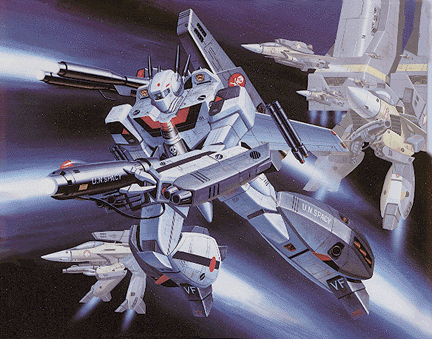 Combat Bonuses For RDF/REF SVA-1 Strike Veritech: | |||||||||||||||||||
Compatible FAST Packs: | |||||||||||||||||||
| Dorsal: NP-BP-01, NP-BP-02, NR-BP-T1, NP-BP-10 Arm: NP-AR-01, NP-AU-T1 | Leg: NP-FB-01, NP-FB-T1, NP-FB-10 | ||||||||||||||||||
